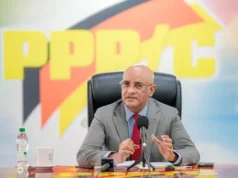By Abena Rockcliffe
The voice of a loud minority continues to echo the call for a renegotiation of the 2016 Production Sharing Agreement (PSA) Guyana has with the ExxonMobil-led consortium, operating the lucrative Stabroek Block.
With election season on the horizon, this call is expected to be amplified. Already, Chartered Accountant and Attorney-at-Law, Christopher Ram is saying that political parties would do well to recognize that the public’s patience is fast evaporating.
Ram has been one of the known voices who sustains the call for the renegotiation of the contract. In his most recent column published in Stabroek News, Ram cited “overwhelming public support” for the renegotiation of the PSA. The public support was garnered from a survey.
Before going further, it is imperative to note that the survey attracted a mere 135 respondents. Ram used this sample audience to deduce that the government’s “sanctity” of contract position is at odds with “public sentiment”.
Some 94% of respondents are in favour of renegotiation. The survey touched on other concerns, including the need for an independent Petroleum Commission, and a review of withdrawal rules for the Natural Resource Fund (NRF). But the main takeaway was for the overall review of the contract.
While it can be easily accepted that the small sample of Guyanese who engaged in the referenced survey, cannot be taken as a representation of the will of the general Guyanese public, it is an interesting exercise to examine what can be Guyana’s fate if the government actually heeds this call for renegotiation.
Ram cited Article 31.2 (Miscellaneous) of the agreement which provides for amendments to the contract. That same provision states, that amendments can only be done with the contractor’s consent.
Further, there is the Article 32.1 (Stability Clause) which states, “Except as may be expressly provided herein, the Government shall not amend, modify, rescind, terminate, declare invalid or unenforceable, require renovation of, compel replacement or substitution, or otherwise seek to avoid, alter, or limit this agreement without the prior written consent for the Contractor.”
But even with such specification in Article 31.1, its relative, Article 32.2, went on to note that there shall be no increases to ExxonMobil’s economic burdens while Article 32.3 addressed even the possibility of making new laws that will essentially affect the terms of the contract.
At every given opportunity, ExxonMobil Guyana made its position known, that it is not even willing to consider contract renegotiation.
While the Stabroek Block operator has never admitted just how lopsided Guyana’s deal is, Guyanese politicians have always acknowledged that reality. Opposition leader, Aubrey Norton has accepted that the contract cannot be renegotiated unless the other party wants to return to the table. He also generally accepts that it would be reckless not to respect the sanctity of the contract.
Vice President and leader of the ruling Party, Bharrat Jagdeo has, on many occasions, spoken about the lopsided nature of the contract. But from all indications, the cons of pushing out ExxonMobil drastically outweigh the pros.
If ExxonMobil is pushed out for the sheer reason of contract renegotiation, then Guyana can be forced to pay costs, a hefty sum ranging in the neighborhood of US$55 billion. And that’s just ExxonMobil’s committed costs to date. Finding that money to pay at a time when your most lucrative industry comes to a sudden halt would be tough, to say the least. Then there will be the legal cost to be borne during arbitration.
But it goes further, the country’s developmental agenda, from infrastructural development to social and legislative development, will have to be put on hold. Not only will Guyana not be able to move forward, maintaining existing infrastructure and funding even current expenditure would be an incredible feat.
The country will have to step backwards from the trillion-dollar budget mark that has been set and several cost-of-living measures may have to stop. The electricity woes that remain a sore and painful reality for Guyanese will persist.
Free university education may have to be taken away again and increases for public servants may become non-existent as the economy will be put under severe strain. Because oil and gas accounts for over 50% of Guyana’s GDP, this will be the reality until the nation can secure another major operator.
While this writer wishes not to delve deeply into this aspect, it would be an injustice to speak about losses if ExxonMobil walks while not highlighting the benefit of having a major US oil company operating the block that forms part of Guyana’s territory being falsely claimed by Venezuela. The US support on this matter is crucial as that nation is known to protect its citizens.
If not ExxonMobil, who?
Another fact that ExxonMobil likes to state, is that Guyana was the underdog. No one wanted to come here to explore for oil. ExxonMobil also likes to remind that Shell gave up hope and pulled out just a year or two before the big find which was announced in May 2015.
Another talk-track for the oil giant is that it had an uphill task finding partners for continued exploration after Shell’s exit. The wells Liza and Skip Jack were slated to be the last two to be drilled before ExxonMobil itself packed up and left. As we have come to know, Skip Jack, drilled in proximity to Liza, turned out to be a dry hole. One of the other partners in the Stabroek Block had wanted Skip Jack to be drilled first; had that been the case, the Liza find would not have been made.
ExxonMobil, in defence of its right to the favourable contact, likes to state these facts. The truth is, as is known, that is the nature of the business. The company takes all the risks upfront, if oil is not found in commercial qualities, then that company takes the loss.
ExxonMobil is one of the biggest oil companies in the world. Leaving out the number of lobbying firms it has on its payroll, let’s focus on this old Guyanese adage, “if breeze blow away mater stick, sifter must tek notice.” Exxon’s operations caused Guyana’s economy to move from one of the lowest performing in Latin America, to the fastest growing in the world. If Exxon is “unfairly” pushed out, who is going to come to invest here?
There is a reason the government often repeats its position of upholding the sanctity of contract, as painfully stated by Ram in his column. Respecting contacts builds investor confidence. No company will trust a volatile landscape. But, for Guyana to move from this latent potential to actual prosperity, she needs massive investments.
Just as Guyana can look to Norway, Dubai and Kuwait for guidance on best practices, the nation should look to countries that made costly mistakes, like Argentina and Venezuela.
Argentina has many factors that make it an attractive investment destination including a skilled workforce, existing infrastructure, natural gas reserves and reasonably low labour cost. The resource is high quality and there is plenty of it. Yet, Argentina is finding it difficult attracting investments. Unlike Venezuela, this is not because of US sanctions. Argentina has been having an extremely hard time securing investments ever since it pushed out Repsol.
When citing reasons not to invest there, international firms and consultants also note other risk/ or deterring factors including the high levels of corruption there and the backed up judicial systems both of which exist in Guyana. But one of the main reasons presented is “weak enforcement” as contracts and property rights are not consistently enforced. This makes Argentina a “risky place for foreign investors.”
Realizing the repercussions of the Repsol fiasco, Argentina paid the company some US$5B and raised hope that the move would restore confidence. It did not work.
While Guyana will hypothetically be saddled with the task of restoring investor confidence, ExxonMobil will take its investments elsewhere, having already recovered a significant amount of its investment here.
Exxon’s committed investment in Guyana totals over US$50B. More than half of this commitment has been expended already. But the company is on the road to securing US$30B in recovered expenses by the end of 2024.
Exxon also anticipates that cost recovery will be complete by 2027, leaving more for Guyana to accrue from its share of profit oil. Why risk it all when the nation is already securing unprecedented revenue, and will receive even more come 2027?













